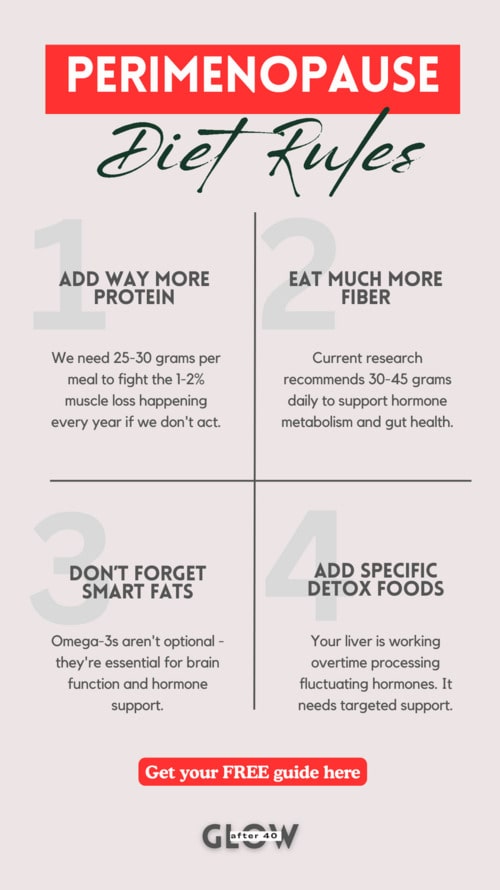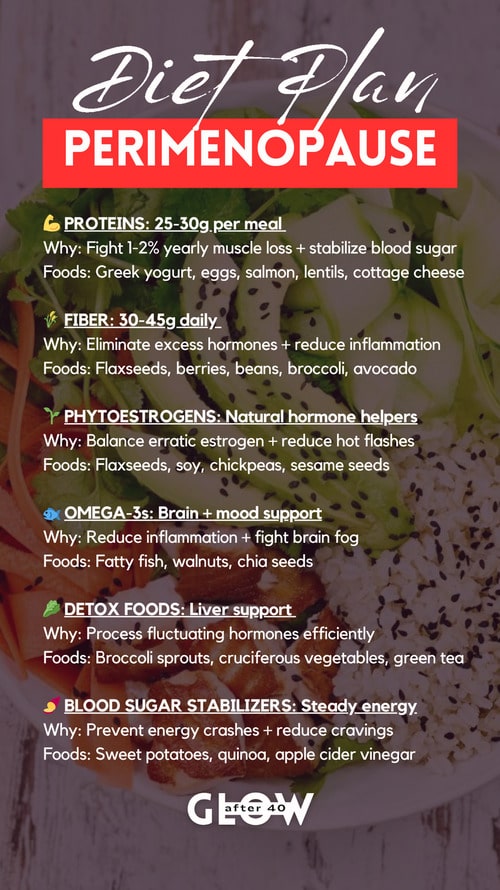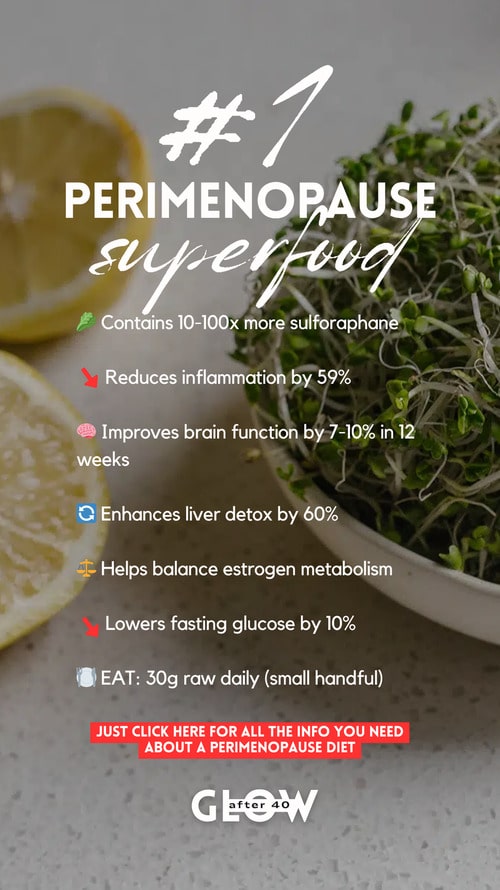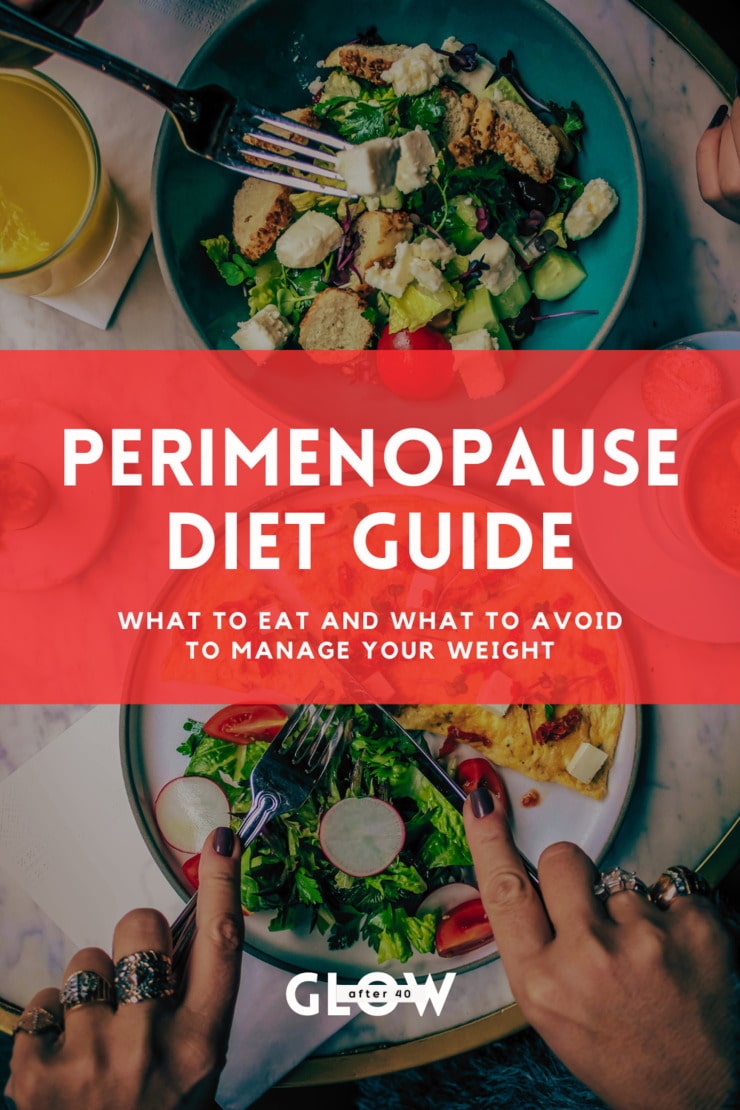What if everything you thought you knew about healthy eating wasn’t enough for perimenopause symptoms? This science-based perimenopausal diet plan reveals why women over 40 need a completely different approach to nutrition. Learn the surprising foods that provide natural cortisol reduction and why your current diet might be making symptoms worse. Stop guessing what to eat and start with this plan that can transform how you feel every day.
Hi, I’m Sofi. I’m 44, mom to three kids, and apparently I’ve lost my ability to speak French.
Last spring I was in Paris – a city where I actually lived for two years. The waitress asked what I’d like to order, and I just… stared at her. Completely blank. I KNOW French. I’ve ordered thousands of meals in French. But my brain just… wasn’t there.
That’s when it hit me: this isn’t just about hot flashes, mood swings and sudden weight gain. Perimenopause is literally changing how my brain works.
But here’s what I learned after diving deep into the latest research:
Your body (and brain) aren’t broken. They just need the right fuel for this transition.
From One Busy Mom to Another
You know that moment when you wake up drenched in sweat at 2 AM, wondering if your thermostat is broken? Or when you’re standing in the kitchen, staring at the fridge, feeling like you could cry over absolutely nothing? Yeah, that’s where I found myself several months ago.
Listen, I totally get it. You’re juggling soccer practice and board meetings, making lunches while answering work emails, and somewhere between helping with homework and folding the never-ending laundry, your body decided to throw you a curveball.
But here’s what I learned after talking to naturopaths, reading research papers at midnight, and yes, crying in my car after another doctor told me “this is just how it is.”
Your body isn’t broken.
It’s not betraying you.
It just needs different support now.
And the beautiful thing? Food can be your strongest ally in this journey.
The Truth They Don’t Tell You About Perimenopause
Most of what you’ll read about perimenopause makes it sound like some kind of disease to cure. But here’s what changed everything for me: understanding that this is a natural transition, not a medical emergency.
Your ovaries are slowly shifting gears. They’re not shutting down overnight. They’re gradually producing less estrogen, but they’re still working. Think of it like dimming lights instead of flipping a switch.
The symptoms you’re experiencing? They’re your body’s way of asking for help. Hot flashes, mood swings, that stubborn belly fat, brain fog – they’re all connected to how your hormones are fluctuating and how your body is adapting.
Here’s the game-changer: even in perimenopause, your body is still making estrogen. The problem isn’t always that you don’t have enough. Sometimes your body just can’t use it effectively because of inflammation, stress, or nutritional gaps.
That’s where smart eating comes in.
We’re not just adding foods. We’re creating an environment where your body can work with what it has.
What the Latest Science Says
Recent studies show four things are absolutely crucial during perimenopause:
- Way More Protein: We need 25-30 grams per meal to fight the 1-2% muscle loss happening every year if we don’t act.
- Much More Fiber: Current research recommends 30-45 grams daily to support hormone metabolism and gut health.
- Smart Fats: Omega-3s aren’t optional – they’re essential for brain function (hello, French-speaking ability!) and hormone support.
- Specific Detox Foods: Your liver is working overtime processing fluctuating hormones. It needs targeted support.

The Power Foods Your Body Needs Now
Protein (30g Per Meal Target)
Why it matters: During perimenopause, declining estrogen directly accelerates muscle protein breakdown while simultaneously reducing our body’s ability to build new muscle tissue. This creates a perfect storm where we can lose 1-2% of muscle mass yearly without adequate protein and strength training.
But here’s the crucial part most women don’t realize: muscle mass isn’t just about looking toned. Your muscles are your metabolic powerhouse, burning calories 24/7, stabilizing blood sugar, and supporting bone density.
When you lose muscle:
- your metabolism slows,
- weight becomes harder to manage,
- and energy crashes become more frequent.
The 30g protein target isn’t arbitrary – it’s the minimum needed to trigger muscle protein synthesis and counteract perimenopause muscle loss.
What to eat:
- Greek yogurt (20g protein per cup)
- Eggs (6g each – have 2-3)
- Cottage cheese
- Salmon, chicken, tofu
- Lentils and chickpeas
- Protein powder in smoothies
- Hemp seeds, chia seeds.
My hack: I aim for a palm-sized portion of protein at every meal. Simple rule that works.
Fiber (30-45g Daily)
Why it matters: Fiber is your secret weapon against the metabolic chaos of perimenopause.
As estrogen fluctuates wildly, your body struggles to process glucose efficiently, leading to blood sugar spikes and crashes that fuel brain fog, mood swings, and energy dips. Fiber acts like a metabolic buffer, slowing sugar absorption and keeping your blood sugar stable. But that’s just the beginning)).
Fiber feeds the beneficial bacteria in your gut – the same bacteria that help metabolize hormones and produce mood-regulating neurotransmitters like serotonin.
During perimenopause, when your body has a harder time processing hormones, fiber helps your body get rid of excess estrogen through regular elimination. If you don’t get enough fiber, these hormones can keep going around in your body, which makes symptoms worse.
Top fiber sources:
- Ground flaxseed (3g per tablespoon) – add to everything, reduce inflammation, aid gut health
- Berries (8g per cup) – antioxidant powerhouses, reduces inflammation, gut issues, anxiety and mood swings
- Beans and lentils (15g per cup) – slow-burning energy
- Oats – helps aid gut health, helps with inner ear problems, reduces night sweats and visceral fat
- Cruciferous vegetables (broccoli, Brussels sprouts, kale) – support healthy digestion
- Dark leafy greens (spinach, Swiss chard) – nutrient-dense fiber
- Artichokes (10g per medium artichoke) – prebiotic fiber
- Avocado (10g per fruit) – creamy, satisfying fiber, helps with hot flashes, bloating, brain fog and mood swings
- Chia seeds (10g per 2 tablespoons) – gel-forming fiber that stabilizes blood sugar
My hack: I add ground flaxseed to everything. Coffee, yogurt, smoothies. Easy fiber boost.
Hormone Helpers (Phytoestrogens)
Why it matters: As your own estrogen production becomes erratic during perimenopause, phytoestrogens act like gentle, natural hormone replacements.
These plant compounds have a similar structure to human estrogen but are much weaker – about 1/1000th the strength. This means they can help fill the gaps when your estrogen drops too low (reducing hot flashes and mood swings) while also preventing estrogen from becoming too dominant when levels spike.
But here’s the bonus: Many of these foods also provide natural cortisol reduction. High cortisol during perimenopause worsens weight gain, disrupts sleep, and intensifies anxiety. By supporting both estrogen balance AND lowering stress hormones, these foods tackle two major perimenopause challenges at once.
Think of them as your body’s natural hormone regulators, providing just enough estrogenic activity to smooth out the wild fluctuations that cause so many perimenopause symptoms.
The superstars:
- Flaxseeds – help balance estrogen (1 tbsp ground daily), reduce inflammation, aid gut health, lower cortisol naturally
- Soy products – reduce hot flashes naturally, support stress hormone balance
- Chickpeas – provide gentle phytoestrogens, help stabilize cortisol
- Sesame seeds – support estrogen levels
- Eggplant – contains beneficial phytoestrogens
YOU MIGHT ALSO LIKE:
7 Simple Ways to Increase Estrogen Naturally
Anti-Inflammatory Foods
Why it matters: Perimenopause triggers a perfect storm of inflammation. Declining estrogen removes your body’s natural anti-inflammatory protection, while stress hormones like cortisol often spike from sleep disruption and life pressures.
This chronic inflammation doesn’t just cause joint aches – it directly worsens brain fog, increases insulin resistance (making weight gain easier), disrupts sleep quality, and can intensify mood swings.
Anti-inflammatory foods help reduce the body’s response to inflammation, which can make perimenopause symptoms worse. The key is consistency. These foods need to be part of your daily routine to build up their protective effects.
- Fatty fish – salmon, sardines, mackerel
- Olives – 10 black or green olives daily reduce inflammation
- Turmeric – reduces inflammation and supports estrogen balance
- Extra virgin olive oil – supports hormone production
- Dark chocolate – reduces stress and supports mood, helps with magnesium intake for sleep, adrenals and cortisol regulation
- Green tea – boosts metabolism and detox, helps reduce cortisol and inflammation
Simple rule: Include healthy fats at every meal. They keep you satisfied and support hormone production.

Blood Sugar Stabilizers
Why it matters: During perimenopause, estrogen levels can change a lot. This can make your cells less responsive to insulin. This can cause blood sugar levels to spike and crash.
These swings don’t just affect your energy. They also trigger hot flashes, worsen mood swings, increase anxiety, and cause those 3 PM energy crashes that make you want to eat sugary snacks.
Stable blood sugar helps you have a steady day. When your glucose levels stay even, your brain can think clearly, your mood stays balanced, and your energy remains consistent.
Stable blood sugar = stable mood.
These foods give you slow-burning energy that keeps you feeling full and mentally alert for a long time.
- Sweet potatoes and quinoa
- Avocado – supports hormone production, helps with hot flashes, bloating, brain fog and mood swings
- Nuts – provide healthy fats for hormone production
- Apple cider vinegar – taken before meals, ACV can lower blood sugar spikes by up to 34% and improve insulin sensitivity. This means fewer energy crashes, reduced cravings, and easier weight management – yes, that’s why my super slim down drink works!!!
YOU MIGHT ALSO LIKE:
Slim Down Drinks That Actually Work After 40
The #1 Perimenopause Superfood
Why it matters: Regular broccoli is healthy, but broccoli sprouts are even healthier. They are like broccoli’s superhero cousin, created to help with perimenopause.
The compound sulforaphane in these tiny sprouts directly targets the three biggest perimenopause problems: inflammation, hormone processing, and brain function. Your liver is working hard to process hormones, and it becomes even better at getting rid of toxins.
The anti-inflammatory effects are so strong that they can reduce inflammatory markers by more than half. For people dealing with brain fog, the good news is that sulforaphane makes it into the brain. It has been shown to improve thinking skills in a few weeks, not months.
Game changer alert: These tiny sprouts contain 10-100x more sulforaphane than regular broccoli.
Science-backed benefits:
- Lowers inflammation by 59% (CRP levels)
- Improves brain function by 7-10% in 12 weeks
- Enhances liver detox by 60%
- Helps balance estrogen metabolism
- Lowers fasting glucose by 10%
How to use: Eat 30g raw daily (small handful) in salads, smoothies, or sandwiches.

Foods That Make Everything Harder
I’m not about restrictions or food shaming. But some foods genuinely make perimenopause symptoms worse, and understanding why helps you make choices that serve you.
Why it matters: Some foods don’t just lack nutrients – they make it harder for your body to deal with perimenopause.
These foods trigger the exact biological pathways that worsen your symptoms:
- spiking insulin (which increases hot flashes),
- promoting inflammation (which intensifies brain fog and joint pain),
- and disrupting sleep (which throws off hormone production the next day).
During perimenopause, your body has less ability to bounce back from these nutritional stressors. If you’re feeling less energetic in your 30s, it might be a sign of something more serious. This change can lead to a full day of mental fog and mood swings. Knowing which foods are hurting your goals can help you make choices that support your health.
Brain Fog Creators
- Refined sugar and processed snacks – blood sugar crashes directly affect cognitive function and worsen brain fog.
- White bread and pastries – sugar crashes make everything worse. Hot flashes. Anxiety. Energy dips.
- Excessive caffeine (especially after 2 PM) ruins your already fragile sleep. If you can – replace coffee with these tasty coffee alternatives, if not – only 1 cup after breakfast (but really AFTER!).
Sleep & Hormone Disruptors
- Alcohol (more than 1 glass) – it feels relaxing but actually disrupts sleep cycles.
- Trans fats (check labels!) increase inflammation.
- Too much salt makes you puffy and affects calcium absorption.
- Processed foods full of weird chemicals stress your liver. Your liver processes hormones.
- Large dinners close to bedtime – make dinner your lightest meal and finish eating at least 3 hours before bed.
YOU MIGHT ALSO LIKE:
Coffee Alternatives for Natural Energy
Why Smart Supplements Matter
Even if you eat perfectly, perimenopause creates unique nutritional needs that you can’t get just from food. Your body is working hard to deal with changing hormones, increased inflammation, and poor sleep.
Strategic supplementation isn’t about replacing good nutrition – it’s about filling the specific gaps that perimenopause creates.
The right supplements can dramatically reduce symptoms, support brain function, improve sleep quality, and help your body navigate this transition more smoothly.
Quality Matters: Not all supplements are created equal. The timing, dosage, and form of nutrients can make the difference between seeing real improvements and wasting your money.
Instead of just guessing, it’s better to know which supplements are backed by solid research for perimenopause.
This can make a big difference in how you feel each day.
YOU MIGHT ALSO LIKE:
Best Supplements for Perimenopause – Complete Evidence-Based Guide
Your 3-Day Quick Start Diet Plan
ADD BROCCOLI SPROUTS to any meal for extra hormone and brain support!
DAY 1
Breakfast (7-8 AM) – Mediterranean Power Bowl with Greek Yogurt ● Plain Greek yogurt with mixed berries, walnuts, almonds, ground flaxseed ● Honey drizzle and fresh mint
Lunch (12-1 PM) – Moroccan Lentil Stew with Tahini Drizzle ● Red lentil stew with cumin, coriander, cinnamon, tomatoes, onions ● Baby spinach and fresh cilantro ● Tahini Lemon Drizzle ● Whole grain pita bread
Dinner (6-7 PM) – Herb-Crusted Salmon with Wilted Spinach ● Herb-crusted salmon with parsley, dill, garlic ● Wilted spinach with garlic and olive oil ● Roasted sweet potato wedges ● Olive Oil & Herb Drizzle
Snack (3-4 PM) – Homemade Trail Mix ● Raw almonds, walnuts, pumpkin seeds ● Dried goji berries and dark chocolate chips
Tea – Red clover tea (reduces hot flashes)
DAY 2
Breakfast (7-8 AM) – Green Goddess Protein Smoothie ● Spinach, kale, avocado, protein powder ● Almond milk, chia seeds, fresh ginger
Lunch (12-1 PM) – Mediterranean Chickpea Wrap with Za’atar ● Whole wheat tortilla with mashed chickpeas ● Cucumber, tomato, red onion, lettuce, spinach ● Feta cheese and Za’atar Seasoning Blend
Dinner (6-7 PM) – Asian Lettuce Cups with Sesame Tofu ● Crispy baked tofu with sesame oil ● Boston lettuce cups with shredded carrots, purple cabbage ● Edamame beans, cilantro, mint ● Sesame Ginger Dressing
Snack (3-4 PM) – Energy Balls ● Dates, cashews, rolled oats, almond butter ● Coconut flakes and vanilla extract
Tea – Sage tea (cooling for hot flashes and night sweats)
DAY 3
Breakfast (7-8 AM) – Cottage Cheese Parfait with Superfood Toppings ● Cottage cheese with strawberries, kiwi ● Pecans, hemp hearts, chia seeds, cinnamon ● Maple syrup drizzle
Lunch (12-1 PM) – Buddha Bowl with Tahini Goddess Dressing ● Quinoa base with roasted Brussels sprouts, sweet potato ● Fresh cucumber, cherry tomatoes, red cabbage ● Avocado slices and Tahini Goddess Dressing
Dinner (6-7 PM) – Greek-Style Turkey Meatballs with Tzatziki ● Turkey meatballs with oregano, parsley, mint ● Roasted zucchini, bell peppers, cauliflower rice ● Homemade Tzatziki Sauce and Kalamata olives
Snack (3-4 PM) – Mediterranean Olive and Walnut Mix ● Mixed olives with walnuts, almonds
Tea – Spearmint tea (balances hormones naturally)
Making It Work in Real Life
You’ve got the foundation—the foods to embrace, the ones to avoid, and proof that eating for perimenopause can be delicious.
But why stop at 3 days when you could have 14 days of carefully planned meals that do all the thinking for you? Transform these guidelines into effortless daily nutrition with our FREE complete perimenopause meal plan: meal plan + recipes + shopping list.
This 14-day perimenopause meal plan actually works to ease your symptoms, balance hormones and lose weight.
Don’t wait another day to start feeling better—your future self is counting on the choice you make right now.
The Bottom Line
Perimenopause brain fog is real. The muscle loss is real. The hormone chaos is real.
But your body’s ability to adapt and thrive with the right support is also real.
Feed it 25-30g protein per meal, 30-45g fiber daily, and specific hormone-supporting foods like broccoli sprouts, olives, and flaxseeds.
Time your meals to support sleep. Choose foods that fight inflammation and support detox.
You’ve navigated pregnancy brain, newborn exhaustion, and teenage drama. You absolutely have the strength to navigate this transition too.
Your body – and brain – deserve fuel that helps them function at their best, not just survive.
With love and solidarity (and hopefully better French next trip),
Sofi
